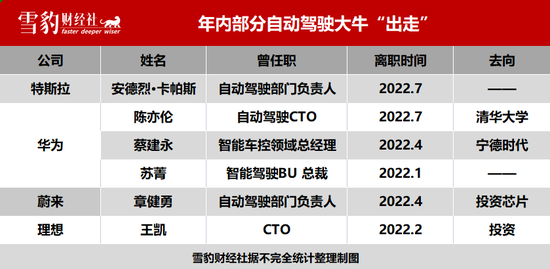
Welcome to the WeChat subscription number of “Sina Technology”: techsina
Text / Yan Xue Gong
Source/Snow Leopard Finance and Economics (ID: xuebaocaijingshe)
There was no tearing, no retention, and Elon Musk’s attitude was very flat when he bid farewell to Andrej Karparthy, the soul of Tesla’s autopilot, on Twitter. He just thanked him in a few words: “It’s a great honor to work with you.”
This is a far cry from the enthusiasm he had when he poached Karpas five years ago.
In 2017, Musk’s dream of autonomous driving was blocked, and Karpas was what he called “the world’s top AI leader.” At that time, Musk’s blueprint was that Tesla could automatically drive from Los Angeles to New York by the end of 2017 without touching the steering wheel. Now nearly 5 years have passed, and the dream is still on the way.
The temperature of the hot autopilot track in the past has plummeted, and parting and farewell have become the new theme. Also left in July, and Huawei’s self-driving CTO Chen Yilun. Earlier, the autonomous driving masters of companies such as Huawei, Weilai, and Ideal have left one after another, and few have re-entered the field.
More precious than gold is confidence. When the fantasy of making miracles by force begins to dissipate, how long will the self-driving capital feast that has lasted for several years last?

The chasm that cannot be bridged is bypassed
Before the smart car leaves the steering wheel, the pillars of autonomous driving leave the car company first.
In March of this year, Karpas announced that he was about to start a four-month furlough trip – an important signal for the departure of executives at Tesla. Karpas promised at the time that he “will definitely come back” and said he missed Tesla’s robots very much, but four months later, the announcement of his departure came too late.
Although Karpas did not bluntly state the reason for his departure, it is not difficult to see one or two from Musk’s recent actions: Silicon Valley Iron Man has always disliked the slow landing of autonomous driving and burning money.
Before Karpas took office, Tesla’s autopilot department had changed several directors on a whim, and the reason behind it was that Musk was dissatisfied with the delay in the autopilot function getting on the car. Karpas also complained about Musk’s rush for quick success: “He wants something to happen right away, and you need to put up with it for a long time.”
What’s more, autonomous driving, which has been unable to land for a long time, is still a big money-burner, and it is also the hardest hit area for layoffs during the period of cost reduction and efficiency improvement.
In early June, Musk said in an email that Tesla needed to lay off 10% of its workforce, citing poor economic conditions. In late June, Tesla laid off about 200 employees from the Assisted Driving Systems team.
Huawei even bluntly said that autonomous driving is a golden beast. In July of this year, Yu Chengdong, CEO of Huawei’s Smart Car Solutions BU, revealed in public that automobiles are Huawei’s only loss-making business, with an annual investment of more than one billion US dollars, of which 70 to 80% of the investment in autonomous driving research and development, with 7,000 people, ” It’s definitely a very expensive business.”
Huawei is also the company with the most self-driving executives leaving this year. As of now, after Chen Yilun resigned as Huawei’s CTO of autonomous driving, he has returned to the ivory tower to continue academic research. Su Jing, the former president of Huawei’s intelligent driving, and Cai Jianyong, general manager of the intelligent vehicle control product department of Huawei’s intelligent car BU, have also resigned.
In April of this year, Zhang Jianyong, the head of NIO’s autonomous driving, announced his resignation, preparing to start a business in the chip industry. The veteran general has been with Weilai for 7 years. In February, Ideal CTO Wang Kai announced his departure after only 17 months of employment.
It is difficult to land and burn a lot of money, which has become a huge gap between ideals and reality. However, car companies that need to be budget-conscious choose to bypass.
No miracle can happen
Autonomous driving has been the most dazzling outlet in the past few years.
In 2016, Ford spent $1 billion to acquire Argo, a self-driving company, and Volkswagen invested another $2.6 billion in the company three years later. Waymo, Google’s autonomous driving division, has raised a total of $3 billion in several rounds of financing, and its valuation in 2018 was as high as $175 billion, equivalent to 1/4 of Google’s market value.
In China, autonomous driving is also one of the most profitable tracks. According to Qichacha data, the total amount of investment and financing in autonomous driving will reach 57.5 billion yuan in 2021, almost six times that of 2019.
In this context, the war to snatch talents with a lot of money is imminent.
According to the US business media Business Insider, the annual salary of R&D personnel of the five major autonomous driving companies in the United States (Argo, Aurora, Cruise, Waymo and Zoox) is 115,000 to 234,000 US dollars, and they will be rewarded with stock. Based on the average annual salary of $174,500, this figure is 38.5% higher than the average annual salary of Silicon Valley programmers of $126,000.
Domestic companies such as Wei Xiaoli and Huawei also hire autonomous driving technicians with an annual salary of one million yuan, and the top titans are worth more. According to the 21st Century Business Herald, in 2019, Ali offered a million-dollar annual salary to two top scientists in the field of visual computing. (For details, please refer to Snow Leopard Finance and Economics Agency “Scientists “Escape” from Big Factory: KPIs Are Difficult to Issue Papers, Big Factory Is Comparable to Pressure Cookers )
In 2021, Weilai will hire two executives from Huawei’s autonomous driving department to serve as senior product managers and algorithm research experts respectively. Ji Krypton also poached the former head of Huawei’s autonomous driving R&D department from Huawei to serve as the vice president of autonomous driving. Xiaomi, who bet on Lei Jun’s reputation for building cars, recruited the former president of Jihu Automobile and the president of Geely Research Institute under his command.
There is a brave man under the heavy money, and the autopilot team of the car company has grown rapidly under the watering of the money.
In a car company, the person in charge of autonomous driving plays a pivotal role, usually reporting directly to the CEO. Before Zhang Jianyong left, Weilai established 4 departments around the autonomous driving business. The heads of each department were promoted to vice presidents and all reported directly to Li Bin. The principle thinks that Wang Kai, the person in charge of automatic driving, is directly airborne as CTO.
Lei Jun personally recruited on Weibo to recruit 500 autonomous driving technicians for Xiaomi Auto, and as of March 2022, the entire Xiaomi Auto team is only 1,000 people. Ideal announced in May 2021 that it would expand its autonomous driving team from 300 to 600. Weilai CEO Li Bin also stated on the Q2 earnings call in 2021 that the autonomous driving team will be expanded from 500 to 800 by the end of the year.
However, the story of the great miracle did not happen. When the optimism gradually dissipated, the self-driving giants who were once admired by many stars went their separate ways.
Find the cheapest route
Once confidence dissipates, pessimism spreads, and it is capital with a keen sense of smell that reacts faster than car companies and top talents in the industry.
In September 2019, Morgan Stanley cut Waymo’s valuation by 40% from $175 billion to $105 billion, considering “a range of obstacles related to the commercialization and advancement of autonomous driving technology.” In March 2022, the Financial Times reported that Waymo’s valuation in a new round of financing is only $30 billion, which is only 1/6 of its peak. In China, the amount of financing in the field of autonomous driving in 2019 decreased by 1/3 year-on-year.
Faced with the current and distant future that cannot be exchanged for burning money, car companies have begun to turn to more cost-effective routes.
For car companies, the ultimate goal of developing autonomous driving technology is to increase sales and improve product premium capabilities. The input-output ratio is an account that has to be calculated.
For now, even Tesla’s FSD (Full Self-Driving Feature Pack) has few consumers paying for it. Tesla disclosed in its 2020 Q4 financial report that the FSD, which sells for $12,000, has an installed rate of only 1% to 2% in the Chinese market. In September 2021, data from Troy Teslike, a market research firm that tracks Tesla, showed that among more than 17,000 Tesla owners worldwide, the FSD usage rate was only about 11%.
When autonomous driving is recognized as a problem that cannot be overcome in a short period of time, continuing to invest with no end in sight is undoubtedly a loss-making business.
In fact, with continuous investment over the years, leading new energy vehicle companies such as Tesla and Wei Xiaoli have accumulated a certain amount of incomplete automatic driving, which is enough to make them compete with traditional car companies. Have a certain first-mover advantage. Going a step further, of course, can open up the position with competitors, but it is difficult and costly, and it is not surprising that car companies have slowed down their investment.
Therefore, after Zhang Jianyong left, NIO disbanded the 400-person team he led as a whole, and no longer retained the position of the person in charge of the autonomous driving system. After Wang Kai resigned, Ideal did not set up a CTO, but co-founder and chief engineer Ma Donghui took charge of R&D.
Compared with autonomous driving, which is difficult to implement and has high risks, car companies have put more energy into branding and product positioning that can bring more short-term benefits.
At this year’s new car launch conference, NIO and Lili rarely mentioned the elements related to autonomous driving, and instead focused their marketing on interior space, car models and product positioning that benchmarked against traditional luxury cars. Among the automotive intelligent solutions provided by Huawei for car companies, autonomous driving is not the core selling point. The promotion focus of the M5 is “the first time the Hongmeng system is on the car”.
As a rare retrograde, BYD is currently planning to independently develop a dedicated chip for intelligent driving. The project is led by the BYD semiconductor team. But this is because BYD has not yet completed the construction of assisted driving-level infrastructure, which is intended to equal the gap with car companies such as Tesla.
The wheels of self-driving are still rolling forward, just a lot slower, and people are learning to adjust their expectations. In front of the diesel, rice, oil and salt, and the stars and sea in the distance, this eternal business problem, have car companies found the best balance?

This article is reproduced from: http://finance.sina.com.cn/tech/csj/2022-08-04/doc-imizirav6697752.shtml
This site is for inclusion only, and the copyright belongs to the original author.